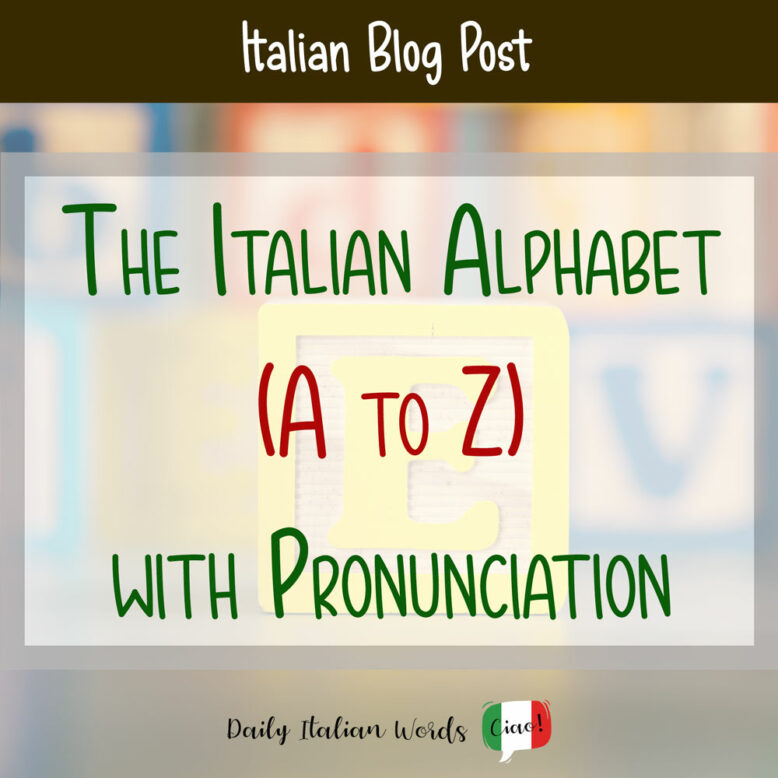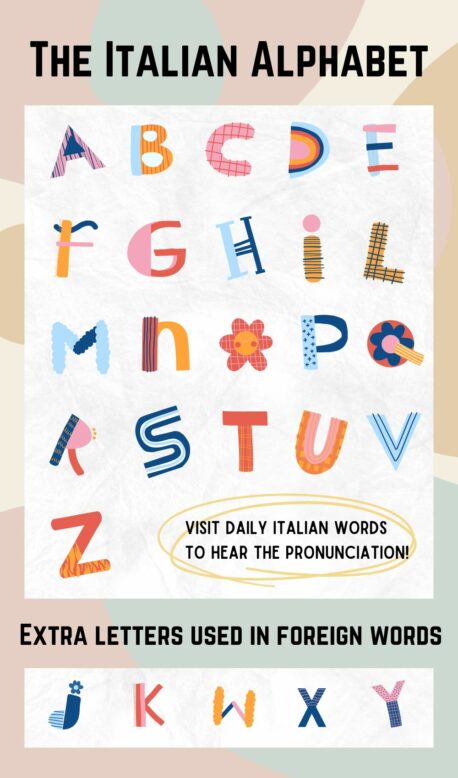When learning a language, one of the first aspects that we must analyse is the alphabet, or more specifically, the ordered sequence of letters and sounds that allow us to read and write. Let’s take a look at the aspects that clearly distinguish the Italian alphabet from those of other languages.
The Italian alphabet derives from the ancient Latin alphabet and is made up of 21 letters, including sixteen consonants and five vowels. On the surface, it looks exactly the same as French, English and other languages, but if you pay close attention to both the pronunciation of the individual letters and another curious detail, which we’ll reveal later on, you will discover that there are many differences.
If you want to learn the Italian language, studying its alphabet can be very useful as it will help you understand the sounds that distinguish it. Let’s start by reading the alphabet in the traditional way and, remember, if you want to learn it in a sequence, you can always accompany it with a melody. This technique makes learning much easier and more fun, not just for kids but also adults!

Italian Alphabet with Pronunciation
A – B – C – D – E – F – G – H – I – L
M – N – O – P – Q – R – S – T – U – V – Z
We have seen a list of all the letters in the Italian alphabet, but when we speak, it’s important to know that these letters are not always pronounced in this manner.
This is where the international phonetic alphabet (IPA) comes in handy! The IPA identifies the sound variations that are created to pronounce words, and can help us better identify the different sounds that define the individual letters. Here we will give examples of everyday words so you can understand how they are pronounced in everyday speech:
The phonetic alphabet
A
IPA symbol: /a/
Example words: allegria (joy), albero (tree)
B
IPA symbol: /b/
Example words: bambino (child), balena (whale)
C
IPA symbol: /k/
Example words: casa (house), conoscere (to know)
IPA symbol: /ʧ/
Example words: cipolla (onion), cena (dinner)
D
IPA symbol: /d/
Example words: delfino (dolphin), destino (destiny)
E
IPA symbol: /ɛ/
Example words: ecco (here, there)
IPA symbol: /e/
Example words: energia (energy), estate (summer)
F
IPA symbol: /f/
Example words: famiglia (family), fontana (fountain)
G
IPA symbol: /g/
Example words: gara (race), gatto (cat)
IPA symbol: /ʤ/
Example words: gelato (ice cream), girare (to spin)
IPA symbol: /ʎ/
Example words: gli (the / to him / to them), aglio (garlic)
IPA symbol: /ɲ/
Example words: gnomo (gnome), gnocchi (gnocchi)
H
IPA symbol:
Example words: ha (has), hanno (have)
Note: H is a silent letter in Italian when it appears at the beginning of a word. Although it is written, it is never pronounced. However, when ‘h’ appears right after the consonants ‘c’ or ‘g’, then it makes the sound hard (e.g. the ‘chia’ in chiaro is pronounced “kia” and the ‘ghia’ in ghiaccio is pronounced “gya”).
I
IPA symbol: /i/
Example words: insalata (salad), isola (island)
L
IPA symbol: /l/
Example words: lavoro (work, job), lana (wool)
M
IPA symbol: /m/
Example words: montagna (mountain), mucca (cow)
N
IPA symbol: /n/
Example words: normale (normal), nuovo (new)
O
IPA symbol: /o/
Example words: occhiali (glasses), ombra (shadow)
IPA symbol: /ɔ/
Example words: oca (goose), olio (oil)
P
IPA symbol: /p/
Example words: porta (door), panda (panda)
R
IPA symbol: /r/
Example words: ristorante (restaurant), rana (frog)
S
IPA symbol: /s/
Example words: sonno (sleepiness), serpente (snake)
IPA symbol: /ʃ/
Example words: scena (scene), sciare (to ski)
IPA symbol: /z/
Example words: svogliato (sluggish), sveglio (awake)
T
IPA symbol: /t/
Example words: tavolo (table), treno (train)
U
IPA symbol: /u/
Example words: uva (grapes), uomo (man)
V
IPA symbol: /v/
Example words: vento (wind), vino (wine)
Z
IPA symbol: /ts/
Example words: zozzo (dirty, rude), pizza (pizza)
IPA symbol: /ds/
Example words: zoo (zoo), zanzara (mosquito)
A curiosity about the Italian alphabet
Did you notice something strange while reading the Italian alphabet? Maybe you are wondering if we forgot some letters or why we didn’t insert them.
A very interesting curiosity is that the Italian alphabet does not include several letters, as originally, Italian words did not use them. Today, in practice, the five foreign letters J, K, Y, X, W are used for words of mostly foreign or Latin derivation. If we want to talk about a 26-letter alphabet, we have to use the term “Latin alphabet”.
Here is the correct pronunciation of the foreign letters and how we use them at the beginning of the words:
J (“gei”)
IPA symbol: /ʤ/
Example words: jet (jet), jeans (jeans)
K (“kappa”)
IPA symbol: /k/
Example words: kiwi (kiwi), ketchup (ketchup)
W (“doppiavu”)
IPA symbol: /w/
Example words: week-end (weekend), windsurf (windsurf)
X (“ics”)
IPA symbol: /ks/
Example words: xilofono (xylophone), xenofobia (xenophobia)
Y (“ipsilon”)
IPA symbol: /j/
Example words: yo-yo (yo-yo), yogurt (yogurt)
The Alphabet Song in Italian
Below is a useful videos that will help you memorise the alphabet in Italian. It includes the five foreign letters mentioned above.

Allegra Lucarelli, known professionally as allegraLu, is a certified Neurolanguage Coach for child bilingualism and a native Italian speaker who speaks English fluently. She helps families raise their children to be bilingual and multilingual at AllegraLu.com.


